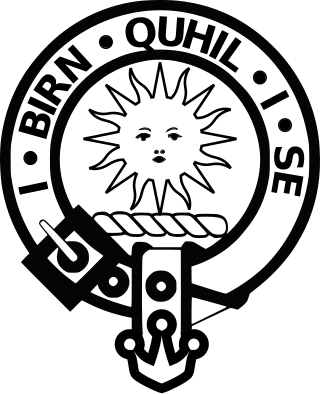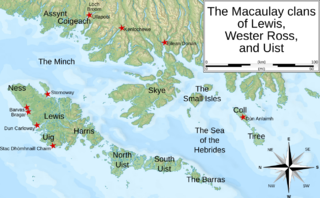
Aberfoyle is a village in the historic county and registration county of Perthshire and the council area of Stirling, Scotland. The settlement lies 27 miles northwest of Glasgow.

South Uist is the second-largest island of the Outer Hebrides in Scotland. At the 2011 census, it had a usually resident population of 1,754: a decrease of 64 since 2001. The island, in common with the rest of the Hebrides, is one of the last remaining strongholds of the Gaelic language in Scotland. South Uist's inhabitants are known in Gaelic as Deasaich (Southerners). The population is about 90% Roman Catholic.

Benbecula is an island of the Outer Hebrides in the Atlantic Ocean off the west coast of Scotland. In the 2011 census, it had a resident population of 1,283 with a sizable percentage of Roman Catholics. It is in a zone administered by Comhairle nan Eilean Siar or the Western Isles Council. The island is about 12 kilometres from west to east and a similar distance from north to south. It lies between the islands of North Uist and South Uist and is connected to both by road causeways. Benbecula's main settlement and administrative centre is Balivanich.

Lochaber is a name applied to a part of the Scottish Highlands. Historically, it was a provincial lordship consisting of the parishes of Kilmallie and Kilmonivaig, as they were before being reduced in extent by the creation of Quoad Sacra parishes in the 19th century. Lochaber once extended from the Northern shore of Loch Leven, a district called Nether Lochaber, to beyond Spean Bridge and Roybridge, which area is known as Brae Lochaber or Braigh Loch Abar in Gaelic. Lochaber is now also used to refer to a much wider area, one of the 16 ward management areas of the Highland Council of Scotland and one of eight former local government districts of the two-tier Highland region. The main town of Lochaber is Fort William.
Leod was the eponymous ancestor and founder of Clan MacLeod and Clan MacLeod of Lewis. Almost nothing is known about him and he does not appear in any contemporary records. Tradition dating to the late 18th century made him a son of Olaf the Black who was King of Man. Heraldic evidence, dating to the late 17th century, is considered to be the earliest evidence of descent from Olaf the Black. However, in recent years, this traditional lineage has been challenged and is no longer considered fact by one historian.
Moidart is part of the remote and isolated area of Scotland, west of Fort William, known as the Rough Bounds. Moidart itself is almost surrounded by bodies of water. Loch Shiel cuts off the eastern boundary of the district and continues along part of the southern edge. The remainder of the southern edge is cut off by Loch Moidart. The north is cut off by Loch Morar and Loch Ailort.

The Battle of the Shirts was a Scottish clan battle that took place in 1544 in the Great Glen, at the northern end of Loch Lochy. The Clan Macdonald of Clanranald and their allies the Clan Cameron fought the Clan Fraser and men from Clan Grant. The battlefield has been included and protected by Historic Scotland in their Inventory of Historic Battlefields in Scotland.

Clan Macdonald of Sleat, sometimes known as Clan Donald North and in Gaelic Clann Ùisdein[kʰl̪ˠan̪ˠ ˈuːʃtʲɛɲ], is a Scottish clan and a branch of Clan Donald — one of the largest Scottish clans. The founder of the Macdonalds of Sleat was Ùisdean, or Hugh, a 6th great-grandson of Somerled, a 12th-century Lord of the Isles. The clan is known in Gaelic as Clann Ùisdein, and its chief's Gaelic designation is Mac Ùisdein, in reference to the clan's founder. Both the clan and its clan chief are recognised by the Lord Lyon King of Arms, who is the heraldic authority in Scotland.

Clan MacLeod of The Lewes, commonly known as Clan MacLeod of Lewis, is a Highland Scottish clan, which at its height held extensive lands in the Western Isles and west coast of Scotland. From the 14th century up until the beginning of the 17th century there were two branches of Macleods: the MacLeods of Dunvegan and Harris ; and the Macleods of the Isle of Lewis. In Gaelic the Macleods of Lewis were known as Sìol Thorcaill, and the MacLeods of Dunvegan and Harris were known as Sìol Thormoid.
Clan Strachan is a Scottish clan originating from the barony of Strachan, in Aberdeenshire. The clan does not have a chief, therefore it is considered by Court of the Lord Lyon and the Stand Council of Scottish Chiefs as an Armigerous clan.

Breacleit is the central village on Great Bernera in the Outer Hebrides, Scotland. Breaclete is within the parish of Uig. Although the village name comes from a geographical feature rather than a steading it is generally believed to be an ancient settlement. The oldest building in the village is the thatched water mill by the shore of Loch Risay which was restored in the 1990s. It was formerly a tiny crofting and fishing settlement of just 12 crofts surrounding the natural harbour of Loch Beag but crofting has now ceased and holiday homes have taken over. The earliest clearly mapped reference is on Murdoch MacKenzie's first Admiralty chart surveyed in 1748. In 1851 J.M. MacKenzie, the Chamberlain to the estate owner Sir James Matheson, proposed that all the tenants of the village were to be evicted and sent to North America on the emigrant ship the SS Marquis of Stafford. This plan was not fully carried through however but it still had a great effect on the village leaving it with a population of just three families. This population was later supplemented through evictions elsewhere notably the clearances of Hacklete and Barragloum villages in the south of Great Bernera.

The Macaulay family of Uig in Lewis, known in Scottish Gaelic as Clann mhic Amhlaigh, were a small family located around Uig on the Isle of Lewis in the Outer Hebrides of Scotland. There is no connection between the Macaulays of Lewis and Clan MacAulay which was centred in the Loch Lomond area, bordering the Scottish Highlands and Scottish Lowlands. The Macaulays of Lewis are generally said to be of Norse origin because of the etymology of their surname and also because of the islands' Viking Age past. However, a recent analysis of the Y-DNA of men with Scottish surnames has shown that a large number of Hebridean Macaulays are of Irish origin. In the 17th century, however, tradition gave the Macaulays an Irish origin. By the end of the 16th century the dominant clan on Lewis was Clan Macleod of The Lewes. Other notable Lewis clans were the somewhat smaller Morrisons of Ness and the even less numerous Macaulays of Uig. The Macaulays were centred in the area surrounding Uig on the western coast of Lewis, and had a deadly, long-standing feud with the Morrisons, whose lands were located on the northern coast around Ness. Today the Lewis surname Macaulay is considered to be a sept name of the Macleods of Lewis. There are two other nearby clans of Macaulays who may, or may not, be connected to the Lewis clan—the Wester Ross Macaulays, and the Uist MacAulays.
Kenneth Mackenzie, the first Lord Mackenzie of Kintail, was a Highland clan chief who secured for himself and his heirs the entirety of the Isle of Lewis in the Outer Hebrides and successfully pursued a bloody feud with the Macdonells of Glengarry.

Clan McCorquodale is a Scottish clan, recognised by the Lord Lyon King of Arms, though without a chief so recognised. The last chief of the clan died in the 18th century. Because the clan does not have a recognised chief, it is considered an armigerous clan, and has no legal standing under Scots Law. Historically, the clan inhabited lands west of Loch Awe, in Argyll. These clan lands were centred at Loch Tromlee, where an island castle served as the clan seat. The line of Clan McCorquodale chiefs, first recorded in the 15th century, has been untraced since the 18th century.

The Highland Clearances were the evictions of a significant number of tenants in the Scottish Highlands and Islands, mostly in two phases from 1750 to 1860.

Nedd is a small village, which lies on the western head of Loch Nedd in Lairg, western Sutherland, Scottish Highlands and is in the Scottish council area of Highland.
William Cleireach MacLeod is considered to be 5th Chief of Clan MacLeod. He was a younger son of chief Iain Ciar and was originally intended to enter the church, as his nickname shows; however, on the death of his elder brother, William Cleireach became the heir to the chiefship. As chief of the clan, he led his followers in attacks against the Frasers and defended his lands against the MacDonalds. He did not live a long life and was said to have been buried on the isle of Iona with his predecessors.
Leod Macgilleandrais is purported to have been a 14th-century Scotsman, who lived in the north-west of Scotland. He is known from clan traditions, which date to the late 17th century. According to these traditions, Leod was a follower of the Earl of Ross, and that he was an enemy of the Mackenzies of Kintail. He is said to have captured one of the early Mackenzie chiefs, and was then later killed by the slain chief's son sometime in the 14th century. His memory is preserved in the place where he is said to have been slain. According to at least one version of the tradition, Leod was survived by a son named Paul. Several historians in 19th and early 20th centuries equated this son to Paul Mactire.
Events from the year 1783 in Scotland.

Clan MacPhail or the Sons of Paul is a Scottish clan of the Scottish Highlands. Known in Scottish Gaelic as Conchie Dhu or Condochy Doye, the clan is mainly associated with the confederation of Clan Chattan.












